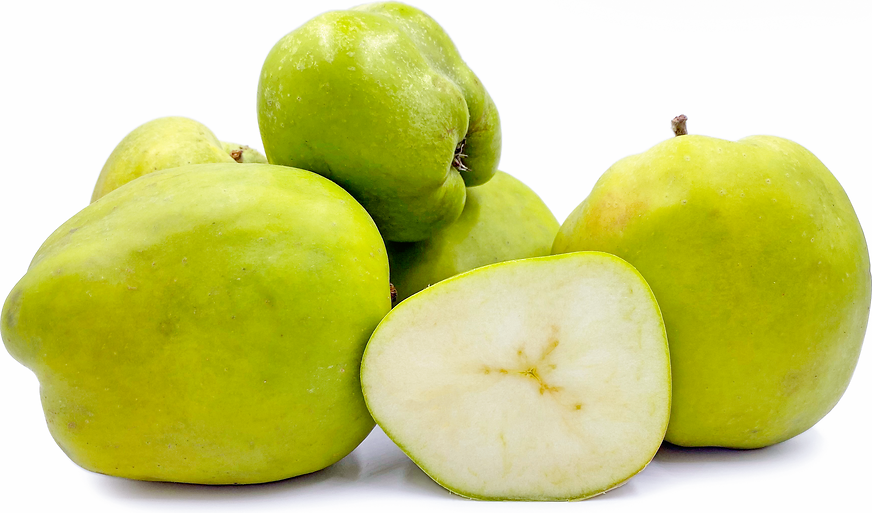


Catshead Apples
Estimated Inventory, lb : 0
Description/Taste
Catshead apples are known for their unusual and irregular appearance, varying in size and having a conical, oblong, angular, to boxy shape. The skin is smooth, thick, and firm with prominent ribbing, ripening to a pale yellow-green when mature. The skin may also develop a red-brown blush on areas exposed to high concentrations of sunlight. Underneath the surface, the flesh is white to cream-colored, coarse, crisp, and aqueous, encasing a small core filled with oval and flat, black-brown seeds. Catshead apples have a semi-sweet, tart, and acidic flavor.
Seasons/Availability
Catshead apples are harvested in the fall and can be stored through the late winter.
Current Facts
Catshead apples, botanically classified as Malus domestica, are a uniquely shaped, heritage variety that belongs to the Rosaceae family. Considered to be one of the oldest varieties still cultivated in England, Catshead apples are named for their angular shape, which some say resembles the head of a cat. Catshead apples are a mid-season cultivar that produces high yields and large fruits. The variety was once widely cultivated in the 19th century, valued as a cooking apple with a sharp flavor, but as more varieties were introduced to the market with improved characteristics, Catshead apples greatly diminished in popularity. In the present day, Catshead apples are primarily found through specialty growers throughout Europe, especially in England, and are a heritage variety that is being promoted for home gardening.
Nutritional Value
Catshead apples are a good source of fiber, which has been shown to help regulate digestion and provide vitamin C, which is an antioxidant that can help boost the immune system and promote collagen production within the body. The apples also contain vitamins A, B, and E, folate, and riboflavin.
Applications
Catshead apples are best suited for cooked applications such as baking and stewing. The flesh is often considered too tart for fresh consumption, but it is valued as a cooking or culinary apple and holds its shape well when baked. Catshead apples are popularly cooked down into a puree and used in apple sauce and jams. They can also be baked into crumbles, cakes, pies, and tarts, sliced into stews, or baked with roasted meats for a sweet and tangy flavor. In addition to cooked applications, the apples are suitable for drying and can be stored for an extended period. Catshead apples pair well with nutmeg, cinnamon, vanilla, crème fraiche, brown sugar, and meats such as pork, beef, wild game, and poultry. The fresh apples will keep up to three months when stored in a cool place such as a cellar or refrigerator. It is important to note that the skin may become greasy when stored for a prolonged period of time, but the fruit is still edible.
Ethnic/Cultural Info
Throughout England, heritage varieties such as Catshead apples are widely promoted to prevent the older varieties from disappearing in the markets. Each October, a festival known as Apple Day is celebrated to showcase the diversity among varieties and to encourage consumers to grow and appreciate unusual apples. The festival was first created at Convent Garden in London in 1990 and was a small, local event, but it quickly grew in popularity and expanded into festivals across the country. During the celebrations, visitors can sample different apple varieties, baked goods, and cider, listen to live music, or converse with fellow gardeners on the best tips for growing heritage varieties. Another unusual, but traditional event that occurs at some of the festivals is known as apple wassailing. This event dates back to ancient times when British farmers sought to protect their orchards from evil spirits. The traditional practices are still followed in the modern-day, and participants gather in the orchard to sing songs, play music, and make loud noises to scare away the spirits. In addition to the musical merriment, hot cider is drunk to toast the trees for a bountiful harvest, and bread slices soaked in cider are placed on the branches and roots of the trees as a blessing and for protection over the orchard.
Geography/History
Catshead apples are believed to be native to England and are one of the oldest apple varieties still in existence in the country. The exact origins of this variety are mostly unknown, with the first recorded document appearing in 1629, but it is believed that the variety was growing prior to 1629 and was simply not recorded until that date. Catshead apples became widely popular across Europe in the 18th and 19th centuries and were one of the first European apples to be brought to America. Once established in the New World, the apples were extensively cultivated in Virginia until the early 20th century when they began to be overshadowed by newer, improved varieties. Today Catshead apples are rare in both Europe and the United States and are primarily found through specialty growers and local markets. The Catshead apples in the photograph above were found at the Perry Court farm stand in Ashford, which is a town in the county of Kent, England.




